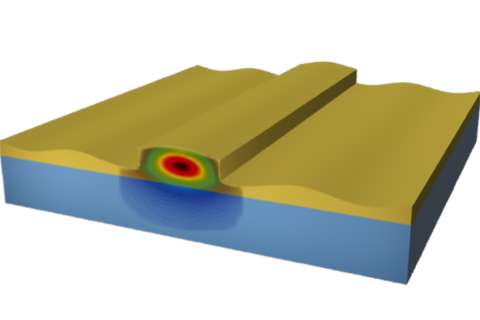The figure illustrates a sound wave passing across an integrated optical waveguide, overlaid with a color map of the light field in it. Credit: University of Minnesota
(Phys.org) —It was a big week for discovery as a Star Trek-like invisible shield was found thousands of miles above Earth—it's in the Van Allen radiation belt and appears to protect the planet below from "killer electrons." Meanwhile, a 23,000-year-old limestone "Venus was dug up in France. The exceptional find is believed to have been carved sometime during the Paleolithic-era and is notable for the realistic rendering of its female features. Yet another team finally discovered the meaning of a handbook that had mystified researchers for 35 years, as an ancient Egyptian codex was finally deciphered. Turns out, it's full of spells and invocations, and cures for common illnesses. Also, another team discovered and was able to analyze a small amount of perovskite found in a meteorite which has finally allowed the world's most abundant mineral to be named: Bridgmanite—it's believed to make up 70 percent of the Earth's lower mantle, but couldn't be officially named until it was analyzed firsthand. And researchers performing an autopsy on a 40,000 year old mammoth discovered blood that brings mammoth cloning closer to reality—they believe there is enough blood to extract a reasonable amount of DNA.
In other interesting news, a team of engineers made a sound loud enough to bend light on a computer chip, allowing for integrating optical circuits in the same layer of material as acoustic devices—that could mean advances in communications devices and possibly open the door to quantum applications. Meanwhile, another team of engineers described how they created a "'superomniphobic" texture capable of repelling all liquids—and it doesn't matter what the surface is made of. They believe it could help slow down corrosion in a wide variety of materials. Also interesting, a team of researchers in Australia reported that they are getting closer to showing how "body recognition" could compare with fingerprint identification. They're looking at a wide variety of body measurements that taken together could serve as a means of identifying a unique individual.
And finally, for those people who thought switching from "real" tobacco cigarettes to the new "fake" kind, to save their health, comes news from a team of researchers in Japan who have found that e-cigarettes contain up to 10 times the carcinogens as tobacco cigarettes. It's because of the mix of materials that makers are putting in them, some of which are essentially poisoning e-smokers.
© 2014 Phys.org
























